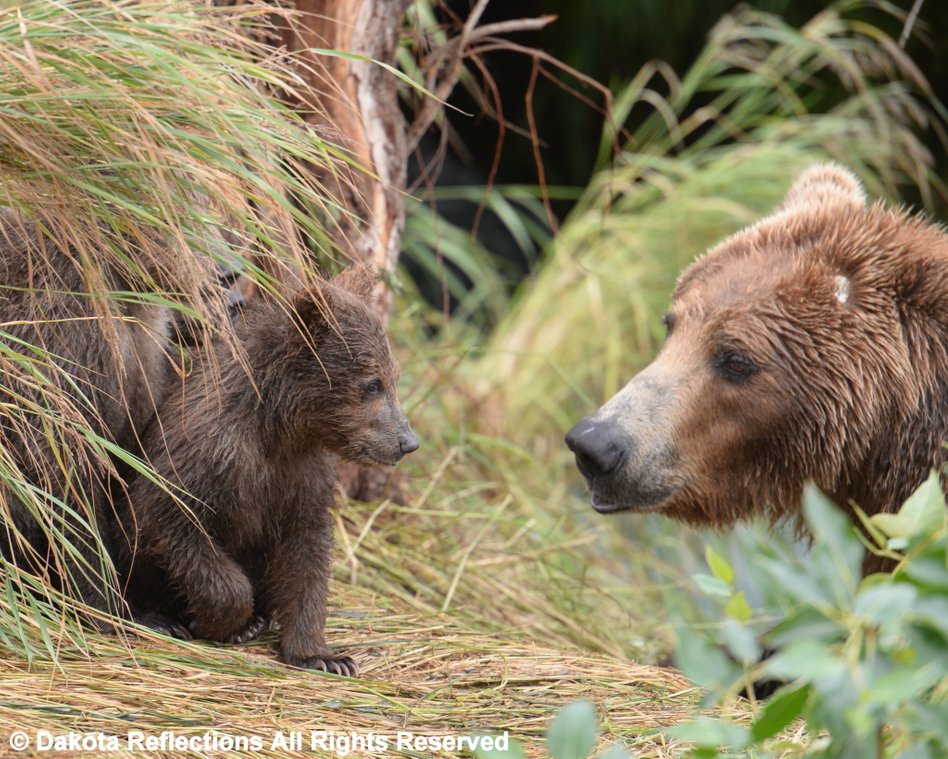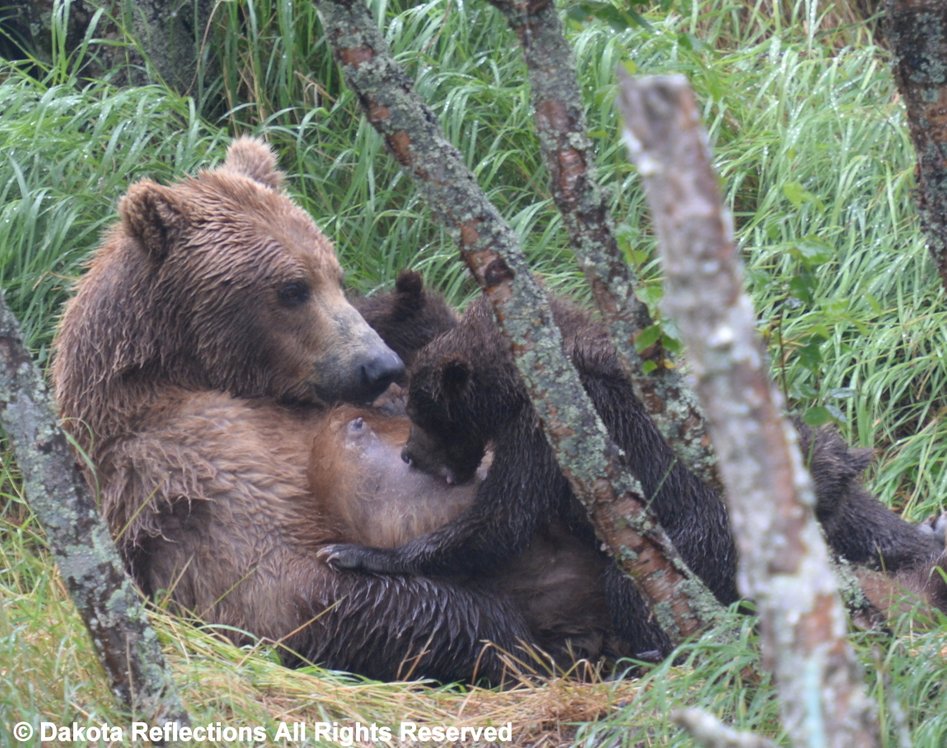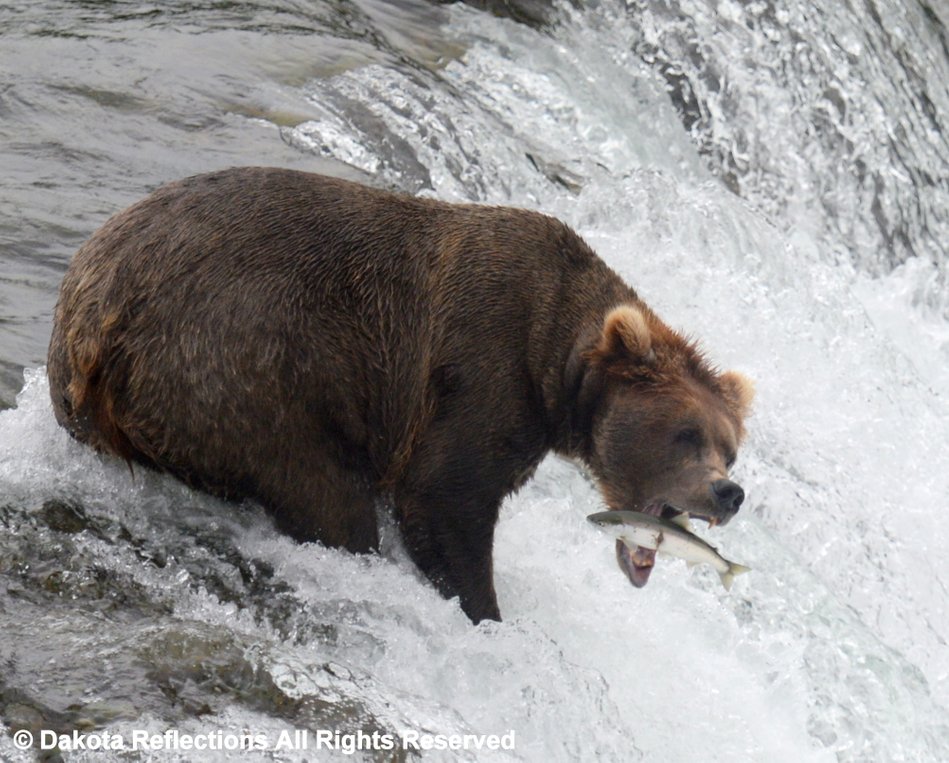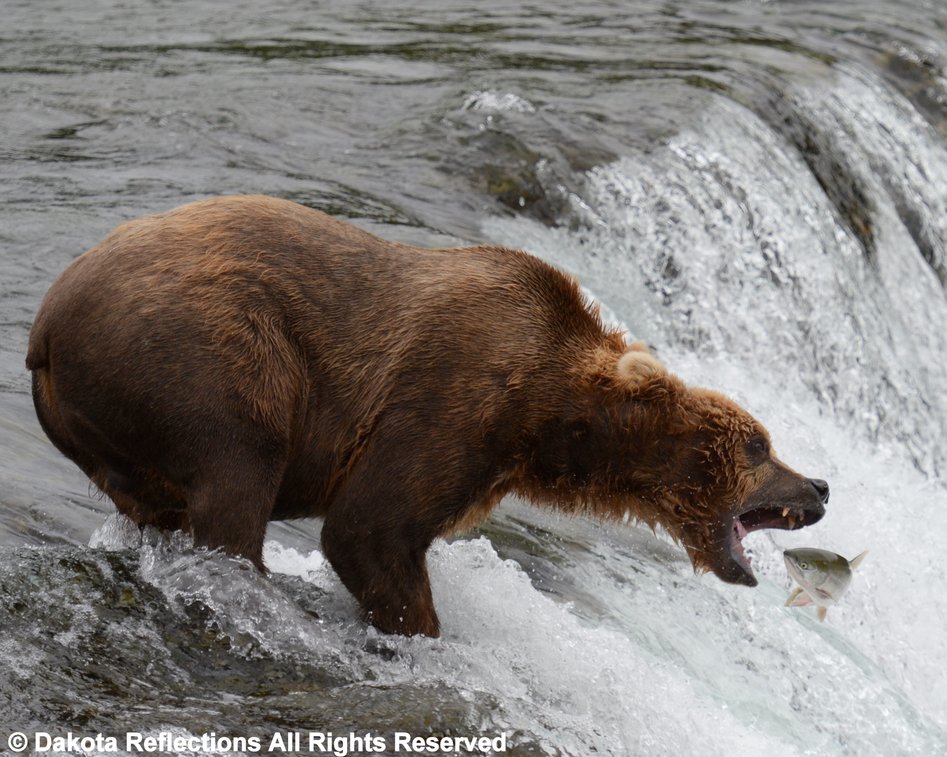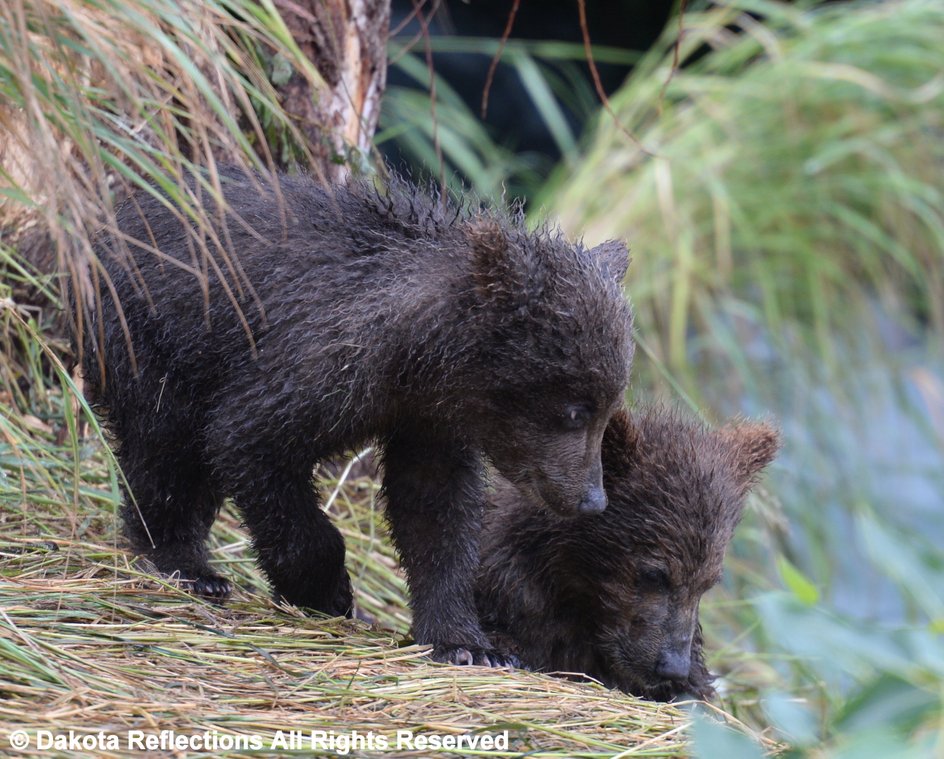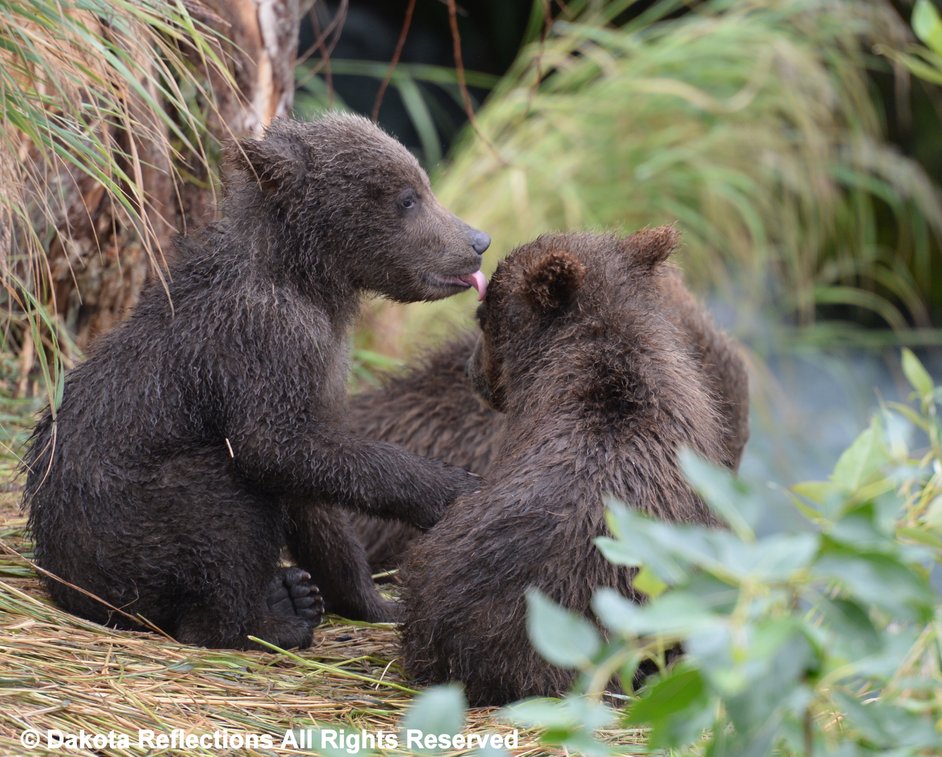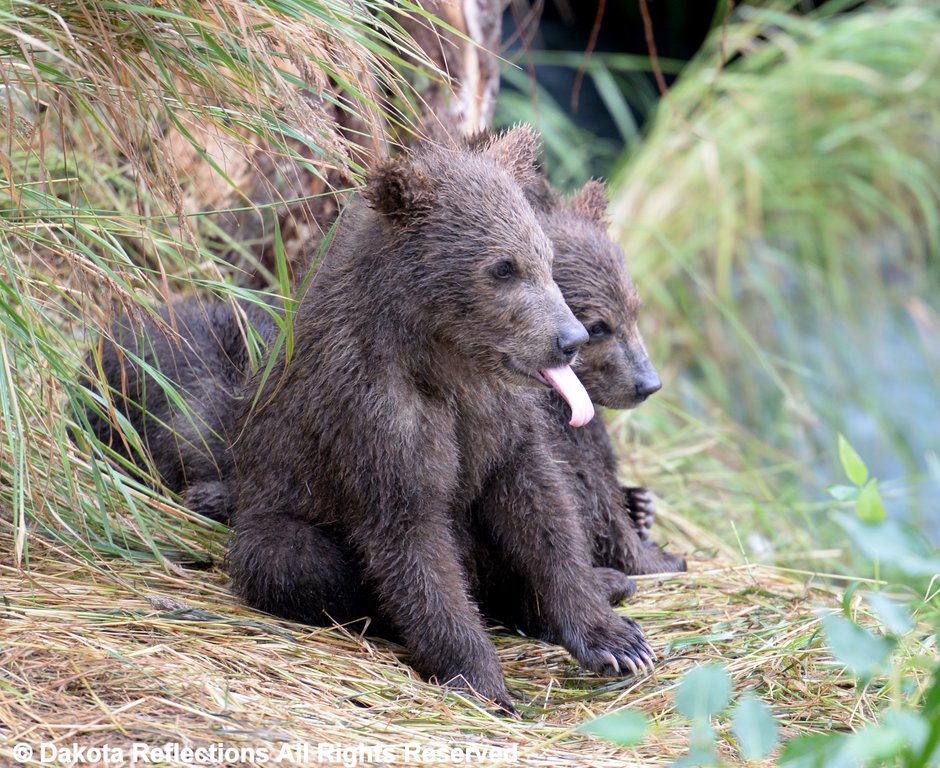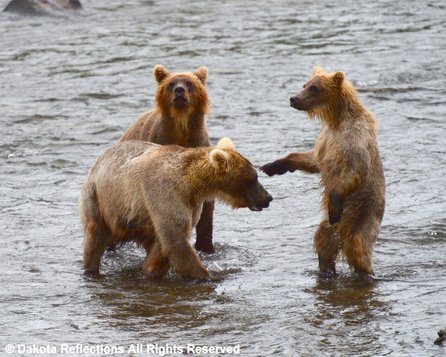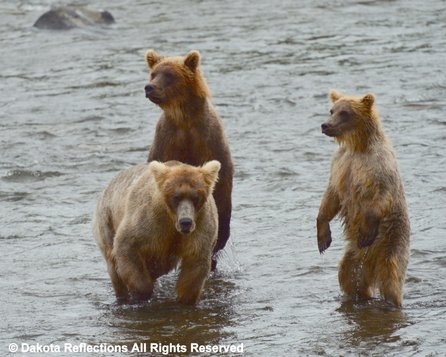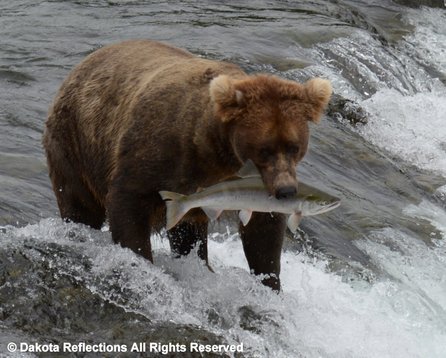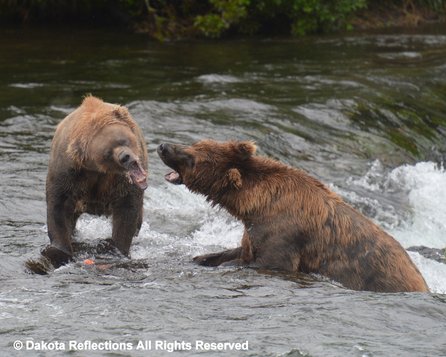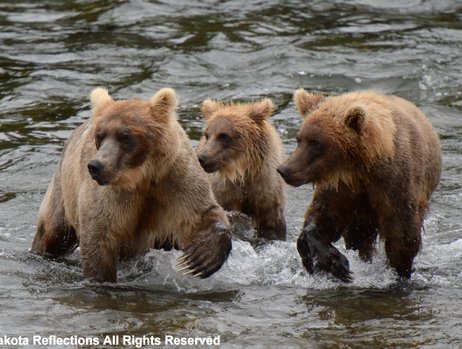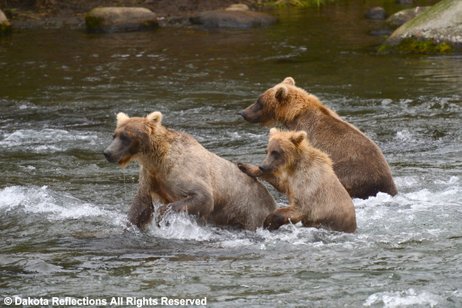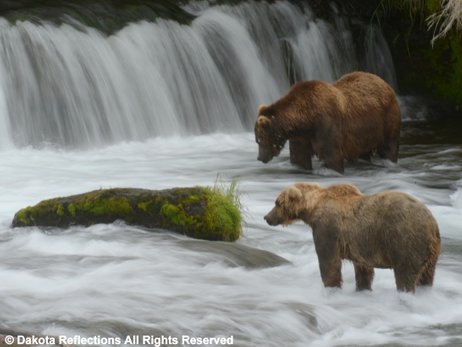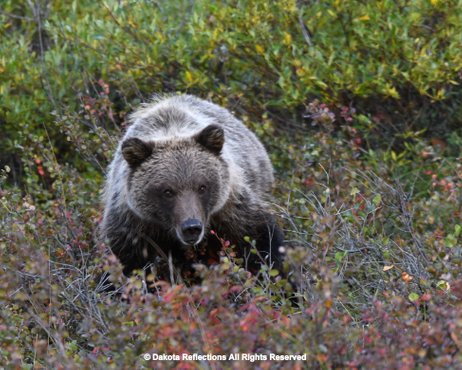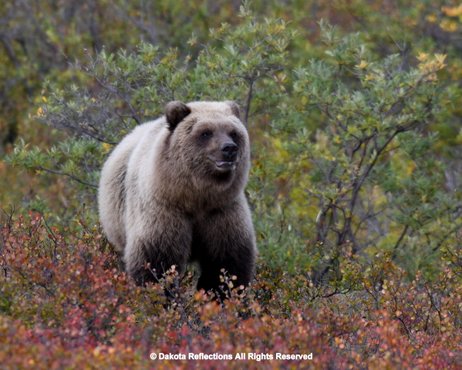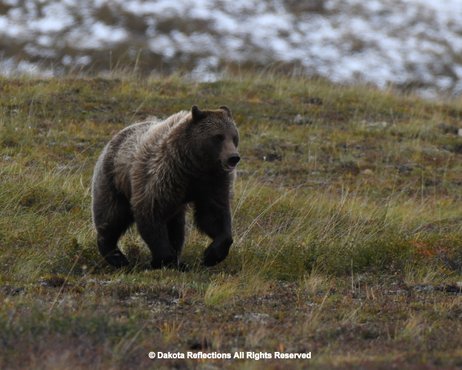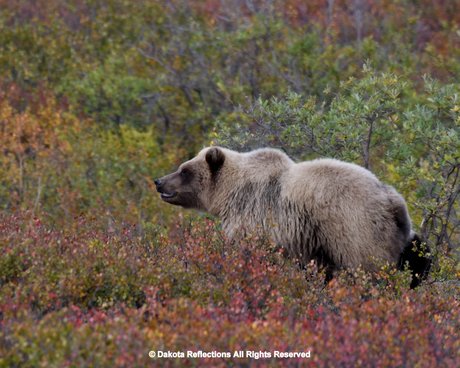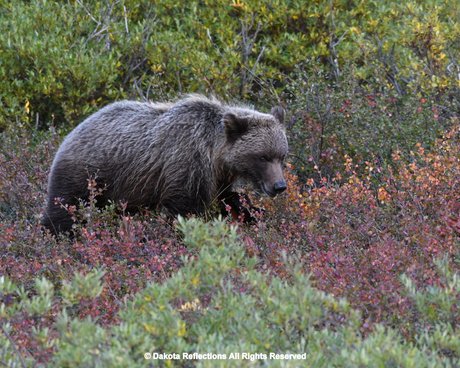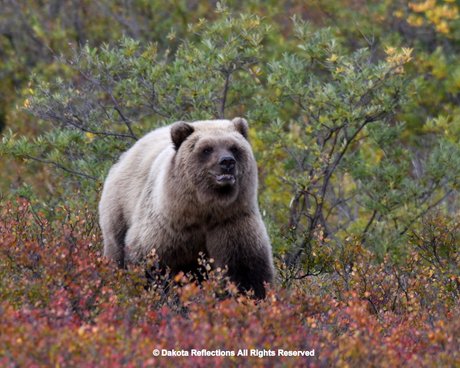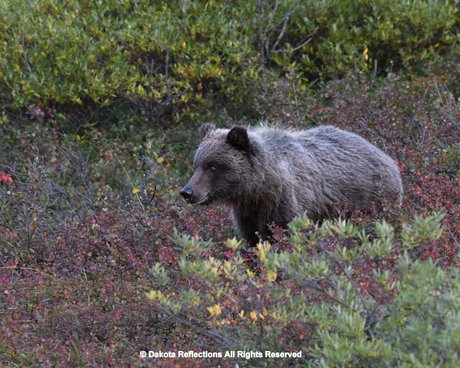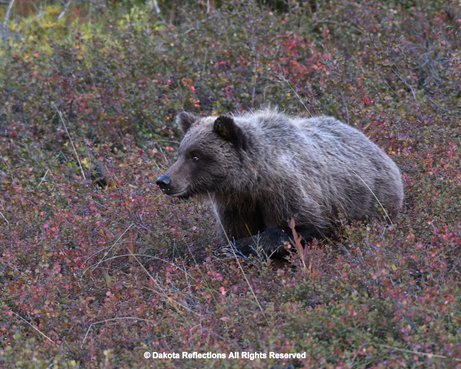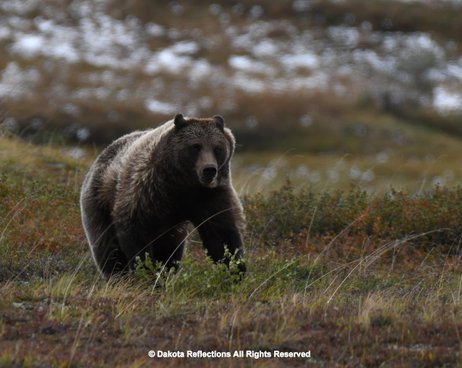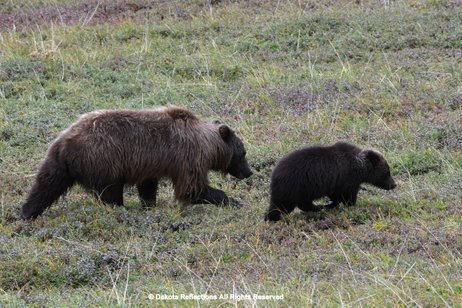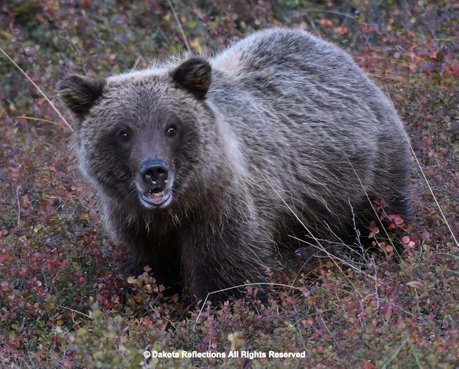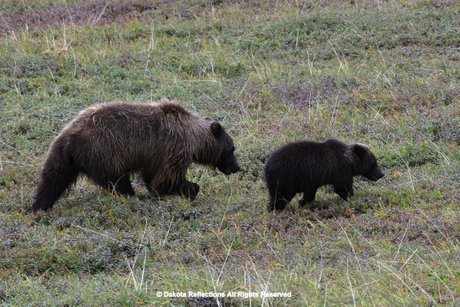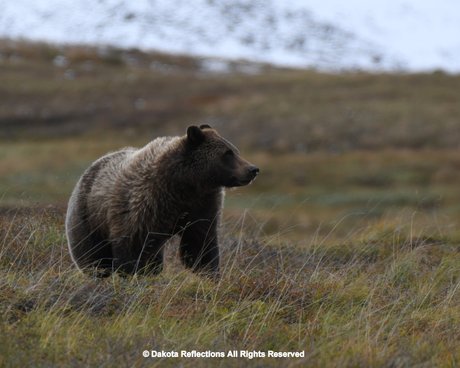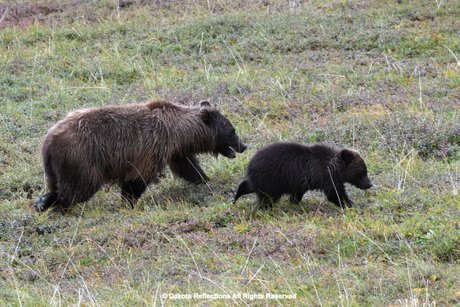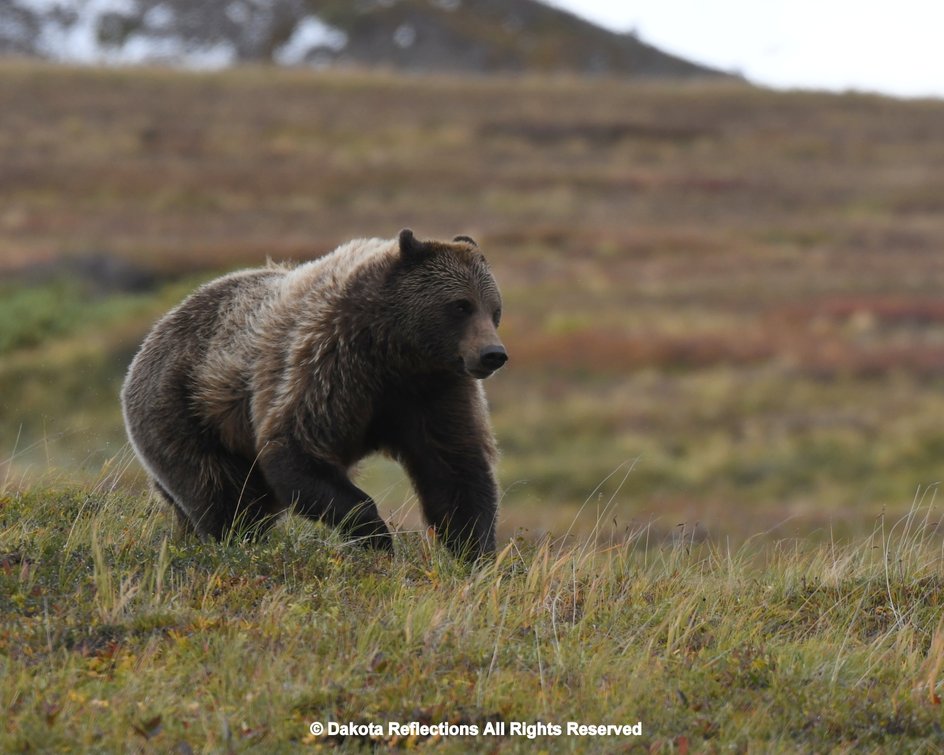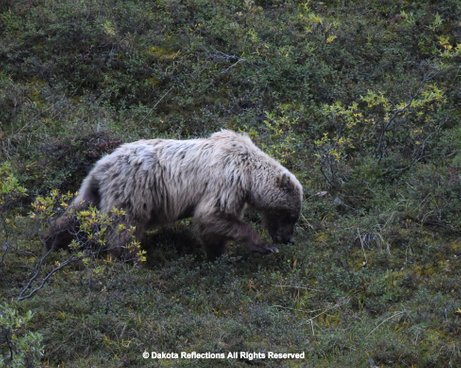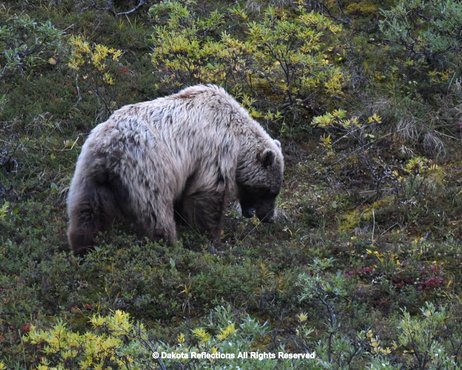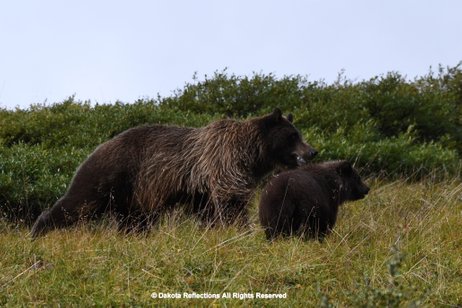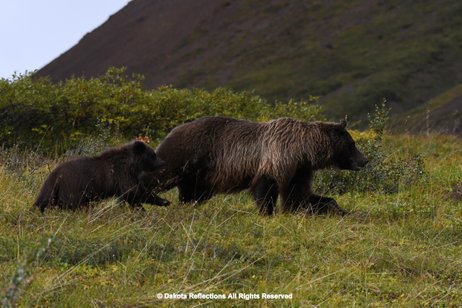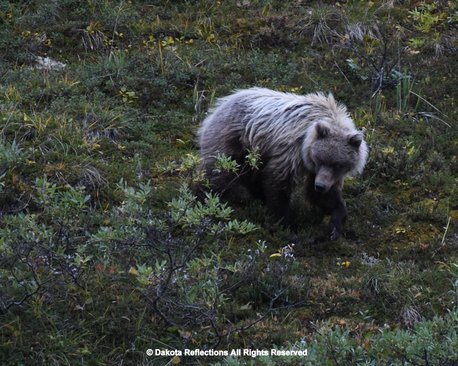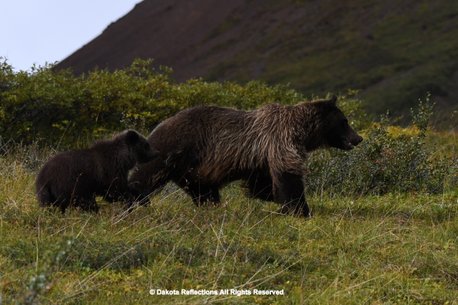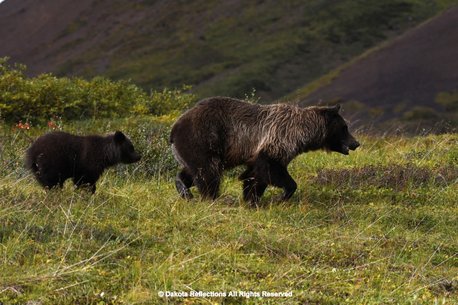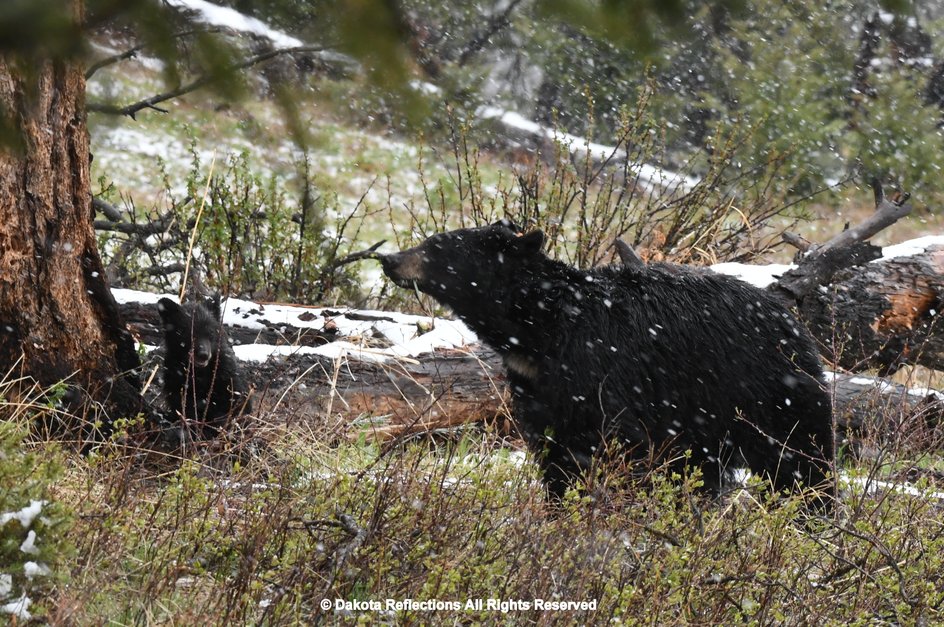Dakota Reflections
Costal brown bears in Alaska can weigh up go 1500 pounds. Males can live to age 25 years while females can live into their 30s. Average liter size is 2 with a range of 1 to 4. Cubs stay with their mom for 2 to 4 years.
Brown bears dig a den in the fall and go in to hibernation. Pregnant female bears will give birth in the den and nurse their babies for several months in the den before emerging in the spring. Bears eat almost anything small mammals, moose, moths, nuts, berries, fruit, leaves, and roots.
Brown bears are usually solitary unless with cubs. However, during salmon runs, brown bears will congregate in large numbers and feast as much as 90 pounds of salmon a day. During these gatherings, bear to bear interaction is fascinating and a pecking order is evident concerning prime fishing areas. Brown bears can move quickly and run up to 30 miles an hour.
Sockeye or red salmon are a common salmon that spawn in the Pacific northwest. The name "sockeye" refers to the term for red salmon in Halkomelem, the language of the indigenou people along the lower region of the Fraser River. In Alaska, sockeye salmon spawn in August through October and then hatch in the spring and become fry or juveniles and live in larger lakes for two years. They then migrate out to sea for 2 to 3 years and return to the stream from which they were born to spawn and die. In Katmai National Park, the sockeye salmon weigh 5 to 7 pounds when they return. Only small percentage survive the life cycle from egg to running the rivers and streams in returning to their spawning grounds.
Brown Bears
Love!
Brown Bear #402 Mom and Cubs
Katmai National Park
Photo of the Day- July 25, 2015
Photo of the Month- July 2015
402, a well known adult female, returned to Brooks River yesterday with a litter of not one, not two, not three, but FOUR spring cubs. Litter size for female brown bears in the Katmai region averages 2-3, so a litter of four cubs is large. It isn’t unprecedented, however. Over the past ten years, we know of four bears, including 402, at Brooks River have had litters of four spring cubs.
- 236 Milkshake in 2003
- 216 Marilyn in 2005
- 236 Milkshake in 2010
- 875 in 2010
- 402 in 2015
https://www.nps.gov/katm/blogs/402-returns-with-four-cubs.htm
Brown Bear Mom
Nursing Four Cubs
Brown Bear Cubs
Three of a Litter of Four
Brown Bear
Catching Sockeye Salmon
Brown Bear
Catching Sockeye Salmon
Brown Bear Cubs
Brown Bear Cubs Grooming
Brown Bear Cubs
Milkshake (Bear 236) with her Four Cubs
Katmai National Park, Alaska
July 22, 2010
236 Milkshake Adult Female
Year First Identified: Adult in 1997
Year Last Identified: 2011
Number of Known Litters: 5
Identification
#236 was a large adult female with a relatively large shoulder hump and a round, filled in body. Her coat was medium-brown in July and in the fall. She had the classic grizzly/brown bear dishshaped face, a rectangular muzzle, and lighter, wide-set ears.
Life History
When last seen in 2011, #236 was one of the older adult females to frequent the Brooks River. She fished the lower river and the lip of the falls. She was first identified in 1997 caring for two spring cubs. She had at least four more litters. Records from the past 20 years indicated that she was one of the most fertile and
successful female bears to use the Brooks River. DNA analysis has confirmed that she is the mother of #604 and #608.
In 2003, #236 was seen with four spring cubs, which is unusual for any sow. Remarkably, she returned in 2010 with four spring cubs, her fifth known litter, but by the end of August 2011, she has lost the entire 2010 litter. The specific causes of her cubs’ deaths remains unknown.
Older females who are raising a litter of cubs may have higher mortality rates than younger, single females. As one of the older sows with cubs in the Brooks River area, a lean salmon run in 2011 may have taxed #236 beyond her physical limits and left her unable to support and defend cubs.
https://www.nps.gov/katm/learn/photosmultimedia/upload/BearsNoLongerSeen2022-Final-508-Copy.pdf
Brown Bear Mom and Cubs
Brown Bear Cubs Standing
Brown Bear Fishing
Brown Bear
Brown Bears
Disagreeing
Sleeping Brown Bear
Brown Bear Mom and Cubs
Brown Bear Family
Brown Bear Snorkeling
Brown Bears
Brown Bears
Discussing Current Events
Brown Bear Itching
That's My Mom!
This grizzly bear cub looked back as me as to say "no worries, I am with my mom." The photograph was taken in September 2018 in Denali National Park.
"Phew, What's that Smell?"
Actually, it was me! I was driving out of Denali National Park in my rental car when I spotted this grizzly bear. As I opened the window to take some photos, the grizzly lifted its head and began to sniff. I had not showered in 6 days and had been sleeping in a tent. Since grizzly bears can smell food 20 miles away, I am not sure what an stinky visitor smells like at 20 yards. In any event, the grizzly had no interest in me and resume eating thousands of blueberries and I went on my way out of the park and back to civilization. Until we meet again!
The photograph was taken in September 2018 in Denali National Park.
You can't outrun a grizzly bear and it is not wise to try!
Grizzly bears can run up to 40 mph, amazing for such a large animal. This female bear was not running after me but from another large male bear. When I am hiking with a camera or backpack, I average 2 miles an hour, no match for a grizzly bear. It is best to give them safe distance or to photograph from the safety of a vehicle. They deserve their space!"
The photograph was taken in September 2018 in Denali National Park.
Bears of Yellowstone National Park
Peek a Boo Black Bear!
Black Bears are the most numerous members of the bear family in North America, and are found from the Pacific to the Atlantic coast. There are an estimated 500-600 black bears inhabiting Yellowstone National Park.
https://yellowstone.net/wildlife/black-bears
Black Bears are very fast and can run up to 30 mph. They are also excellent at quickly climbing and descending trees which I witnessed several times in Yellowstone National Park.
Up to 85% of the American black bear's diet consists of vegetation, though they tend to dig less than brown bears, eating far fewer roots, bulbs, corms and tubers than the latter species. When initially emerging from hibernation, they will seek to feed on carrion from winter-killed animals and newborn ungulates. As the spring temperature warms, American black bears seek new shoots of many plant species, especially new grasses, wetland plants and forbs. Young shoots and buds from trees and shrubs during the spring period are also especially important to American black bears emerging from hibernation, as they assist in rebuilding muscle and strengthening the skeleton and are often the only digestible foods available at that time. During summer, the diet largely comprises fruits, especially berries. During the autumn hyperphagia, feeding becomes virtually the full-time task of American black bears. Favored masts such as hazelnuts, oak acorns and whitebark pine nuts may be consumed by the hundreds each day by a single American black bear during the fall. During the fall period, American black bears may also habitually raid the nut caches of tree squirrels. Also extremely important in fall are berries such as huckleberries and buffalo berries.
https://en.wikipedia.org/wiki/American_black_bear
The black bear has a straight face when seen in profile. Its eyes are small and the ears are well-rounded. It has 42 teeth: 12 incisors, 4 canines, 16 premolars and 10 molars. The canines are long and well pointed; the premolars are rudimentary or even missing; and the molars have flat crowns. People have 32 teeth.
http://www.bebearaware.org/Bears_of_North_America/bears_of_north_america.html
What a Wonderful Mom!
I was over 100 yards away from this Grizzly Bear Mom nursing her two cubs in Yellowstone National Park. Grizzly Bear Moms will nurse her cubs for over 2 years, all the time protecting them from other bears.
Baby has an Itch!
Mom has to Stretch while Babies Nurse!
Babies Love to Play!
2021 Photos
Cinnamon Black Bear
Yellowstone National Park
May 21, 2021
Cinnamon Black Bear
Yellowstone National Park
May 21, 2021
Grizzly Bears
Yellowstone National Park
May 22, 2021
Cinnamon Black Bear
Yellowstone National Park
May 23, 2021
Cinnamon Black Bear
Yellowstone National Park
May 23, 2021
Cinnamon Black Bear
Yellowstone National Park
May 23, 2021
Black Bear
Yellowstone National Park
May 23, 2021
Black Bear
Yellowstone National Park
May 23, 2021
Black Bear Cub
Yellowstone National Park
May 23, 2021
Black Bear Cub
Yellowstone National Park
May 23, 2021
"What is the White Stuff?"
Black Bear Mom and Spring Cub
Yellowstone National Park
May 23, 2021
Black Bear Mom and Spring Cub
Yellowstone National Park
May 23, 2021
Black Bear Cub
Yellowstone National Park
May 23, 2021

